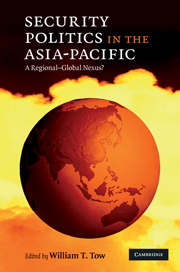Book contents
- Frontmatter
- Contents
- List of illustrations
- About the contributors
- Preface
- Acknowledgements
- List of abbreviations
- 1 Setting the context
- Part I
- Part II
- Part III
- 11 Problematising ‘linkages’ between Southeast Asian and international terrorism
- 12 Nuclear weapons: Asian case studies and global ramifications
- 13 Maritime security: regional concerns and global implications
- 14 Thinking globally and acting regionally: securitising energy and environment
- 15 Regional health and global security: the Asian cradle of pandemic influenza
- Part IV
- References
- Index
12 - Nuclear weapons: Asian case studies and global ramifications
Published online by Cambridge University Press: 05 June 2012
- Frontmatter
- Contents
- List of illustrations
- About the contributors
- Preface
- Acknowledgements
- List of abbreviations
- 1 Setting the context
- Part I
- Part II
- Part III
- 11 Problematising ‘linkages’ between Southeast Asian and international terrorism
- 12 Nuclear weapons: Asian case studies and global ramifications
- 13 Maritime security: regional concerns and global implications
- 14 Thinking globally and acting regionally: securitising energy and environment
- 15 Regional health and global security: the Asian cradle of pandemic influenza
- Part IV
- References
- Index
Summary
Introduction
This chapter examines the regional and global impacts of nuclear weapons development in two crucial areas of the Asia-Pacific: the South Asia subregion and North Korea. Both the South Asian and Northeast Asian subregions came to attention in the 1990s as a result of widespread concerns about nuclear weapons proliferation. While some of these concerns have been modified recently, this has occurred for very different reasons in each case. This has been a reflection of the quite different circumstances surrounding each of these developments, in terms of the motivations behind the states' search for nuclear weapons, the effects that each case of proliferation has had at the regional and global levels, and the way in which each of them has come to be viewed by the international community more broadly. What both episodes share, however, is the dubious distinction of having unsettled existing norms of regional and global strategic behaviour, of having ‘thrown down the gauntlet’ to prevailing nuclear powers dominating international security by crossing the nuclear threshold.
One way of viewing nuclear developments in these regions is to think of them as having become relatively ‘settled’. The Indian–Pakistan case is seen as sui generis, and as such is not viewed as posing a threat to states outside this direct relationship (although the China factor cannot be separated from this case).
- Type
- Chapter
- Information
- Security Politics in the Asia-PacificA Regional-Global Nexus?, pp. 228 - 246Publisher: Cambridge University PressPrint publication year: 2009



